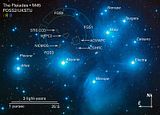Also known as Messier 45 (or M45), the Pleiades is a visual delight on a cold winter’s night and has been a favorite target of stargazers since antiquity. Because of it’s large angular size, this open cluster looks far better in binoculars or a finderscope than a telescope. The Pleiades formed some 100 million years ago, and is still enveloped in dusty nebulosity. It’s some 445 light years away; the light striking your eye from the Pleiades left the year William Shakespeare was born, give or take a few decade. The nine brightest stars of the Pleiades are named for the Seven Sisters in Greek mythology, Alcyone, Maia, Asterope, Merope, Electra, Taygete, Celaeno, along with their parents Atlas and Pleione. Most people can only see six of these stars with the naked eye.

source....
No comments:
Post a Comment